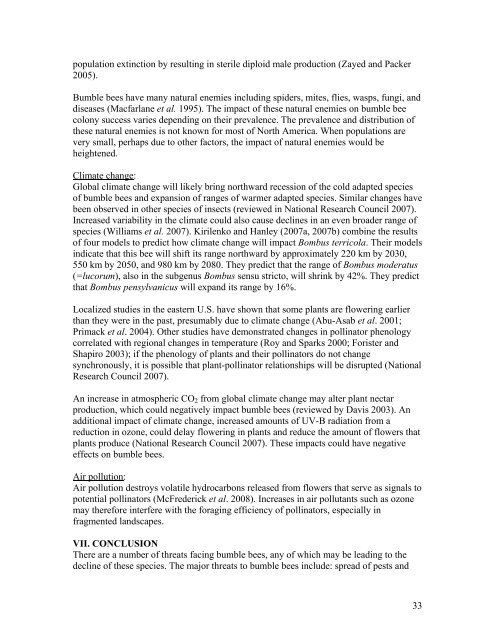Status Review of Three Formerly Common Species of Bumble Bee ...
Status Review of Three Formerly Common Species of Bumble Bee ...
Status Review of Three Formerly Common Species of Bumble Bee ...
Create successful ePaper yourself
Turn your PDF publications into a flip-book with our unique Google optimized e-Paper software.
population extinction by resulting in sterile diploid male production (Zayed and Packer2005).<strong>Bumble</strong> bees have many natural enemies including spiders, mites, flies, wasps, fungi, anddiseases (Macfarlane et al. 1995). The impact <strong>of</strong> these natural enemies on bumble beecolony success varies depending on their prevalence. The prevalence and distribution <strong>of</strong>these natural enemies is not known for most <strong>of</strong> North America. When populations arevery small, perhaps due to other factors, the impact <strong>of</strong> natural enemies would beheightened.Climate change:Global climate change will likely bring northward recession <strong>of</strong> the cold adapted species<strong>of</strong> bumble bees and expansion <strong>of</strong> ranges <strong>of</strong> warmer adapted species. Similar changes havebeen observed in other species <strong>of</strong> insects (reviewed in National Research Council 2007).Increased variability in the climate could also cause declines in an even broader range <strong>of</strong>species (Williams et al. 2007). Kirilenko and Hanley (2007a, 2007b) combine the results<strong>of</strong> four models to predict how climate change will impact Bombus terricola. Their modelsindicate that this bee will shift its range northward by approximately 220 km by 2030,550 km by 2050, and 980 km by 2080. They predict that the range <strong>of</strong> Bombus moderatus(=lucorum), also in the subgenus Bombus sensu stricto, will shrink by 42%. They predictthat Bombus pensylvanicus will expand its range by 16%.Localized studies in the eastern U.S. have shown that some plants are flowering earlierthan they were in the past, presumably due to climate change (Abu-Asab et al. 2001;Primack et al. 2004). Other studies have demonstrated changes in pollinator phenologycorrelated with regional changes in temperature (Roy and Sparks 2000; Forister andShapiro 2003); if the phenology <strong>of</strong> plants and their pollinators do not changesynchronously, it is possible that plant-pollinator relationships will be disrupted (NationalResearch Council 2007).An increase in atmospheric CO 2 from global climate change may alter plant nectarproduction, which could negatively impact bumble bees (reviewed by Davis 2003). Anadditional impact <strong>of</strong> climate change, increased amounts <strong>of</strong> UV-B radiation from areduction in ozone, could delay flowering in plants and reduce the amount <strong>of</strong> flowers thatplants produce (National Research Council 2007). These impacts could have negativeeffects on bumble bees.Air pollution:Air pollution destroys volatile hydrocarbons released from flowers that serve as signals topotential pollinators (McFrederick et al. 2008). Increases in air pollutants such as ozonemay therefore interfere with the foraging efficiency <strong>of</strong> pollinators, especially infragmented landscapes.VII. CONCLUSIONThere are a number <strong>of</strong> threats facing bumble bees, any <strong>of</strong> which may be leading to thedecline <strong>of</strong> these species. The major threats to bumble bees include: spread <strong>of</strong> pests and33
















